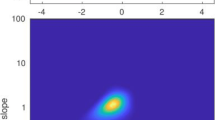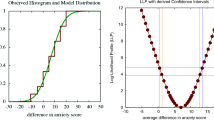Abstract
A MATLAB toolbox for the efficient estimation of the threshold, slope, and lapse rate of the psychometric function is described. The toolbox enables the efficient implementation of the updated maximum-likelihood (UML) procedure. The toolbox uses an object-oriented architecture for organizing the experimental variables and computational algorithms, which provides experimenters with flexibility in experimental design and data management. Descriptions of the UML procedure and the UML Toolbox are provided, followed by toolbox use examples. Finally, guidelines and recommendations of parameter configurations are given.








Similar content being viewed by others
Notes
A well-organized list of software available for the analysis of psychophysical functions, as well libraries/toolboxes for the collection of psychophysical data is available at http://visionscience.com/documents/strasburger/strasburger.html.
Although the current toolbox was developed for the MATLAB environment, all source codes are contained in the toolbox and can be modified into other programing environments or languages.
Reference
Brainard, D. H. (1997). The psychophysics toolbox. Spatial Vision, 10, 433–436. doi:10.1163/156856897X00357
Brand, T., & Kollmeier, B. (2002). Efficient adaptive procedures for threshold and concurrent slope estimates for psychophysics and speech intelligibility tests. Journal of the Acoustical Society of America, 111, 2801–2810.
Derman, C. (1957). Non-parametric up-and-down experimentation. Annals of Mathematical Statistics, 28, 795–798. doi:10.1214/aoms/1177706895
Durham, S. D., & Flournoy, N. (1995). Up-and-down designs I: Stationary treatment distributions. In N. Flournoy & W. F. Rosenberger (Eds.), Adaptive designs: Papers from the Joint AMS–IMS–SIAM Summer Conference held at Mt. Holyoke College, South Hadley, MA, July 1992 (pp. 139–157). Hayward, CA: Institute of Mathematical Statistics.
Emerson, P. L. (1986a). Observations on maximum likelihood and Bayesian methods of forced choice sequential threshold estimation. Perception & Psychophysics, 39, 151–153.
Emerson, P. L. (1986b). A quadrature method for Bayesian sequential threshold estimation. Perception & Psychophysics, 39, 381–383.
Fründ, I., Haenel, N. V., & Wichmann, F. A. (2011). Inference for psychometric functions in the presence of non-stationary behavior. Journal of Vision, 11(6), 16. doi:10.1167/11.6.16
Garcia-Perez, M. A. (1998). Forced-choice staircases with fixed step sizes: Asymptotic and small-sample properties. Vision Research, 38, 1861–1881.
Grassi, M., & Soranzo, A. (2009). MLP: A MATLAB toolbox for rapid and reliable auditory threshold estimation. Behavior Research Methods, 41, 20–28. doi:10.3758/BRM.41.1.20
Green, D. M. (1990). Stimulus selection in adaptive psychophysical procedures. Journal of the Acoustical Society of America, 87, 2662–2674.
Gu, X., & Green, D. M. (1994). Further studies of a maximum-likelihood yes–no procedure. Journal of the Acoustical Society of America, 96, 93–101.
Hall, J. L. (1968). Maximum-likelihood sequential procedure for estimation of psychometric functions [Abstract]. Journal of the Acoustical Society of America, 44, 370. doi:10.1121/1.1970490
Hall, J. L. (1981). Hybrid adaptive procedures for the estimation of psychometric functions. Journal of the Acoustical Society of America, 69, 1763–1769.
Harvey, L. O., Jr. (1986). Efficient estimation of sensory thresholds. Behavior Research Methods, Instruments, & Computers, 18, 623–632.
Harvey, L. O., Jr. (1997). Efficient estimation of sensory thresholds with ML-PEST. Spatial Vision, 11, 121–128. doi:10.1163/156856897X00159
Kaernbach, C. (1991). Simple adaptive testing with the weighted up–down method. Perception & Psychophysics, 49, 227–229. doi:10.3758/BF03214307
Kaernbach, C. (2001). Slope bias of psychometric functions derived from adaptive data. Perception & Psychophysics, 63, 1389–1398.
King-Smith, P. E., Grigsby, S. S., Vingrys, A. J., Benes, S. C., & Supowit, A. (1994). Efficient and unbiased modifications of the QUEST threshold method: Theory, simulations, experimental evaluation and practical implementation. Vision Research, 34, 885–912.
King-Smith, P. E., & Rose, D. (1997). Principles of an adaptive method for measuring the slope of the psychometric function. Vision Research, 37, 1595–1604.
Klein, S. A. (2001). Measuring, estimating, and understanding the psychometric function: A commentary. Perception & Psychophysics, 63, 1421–1455.
Kontsevich, L. L., & Tyler, C. W. (1999). Bayesian adaptive estimation of psychometric slope and threshold. Vision Research, 39, 2729–2737.
Lam, C. F., Dubno, J. R., Ahlstrom, J. B., He, N. J., & Mills, J. H. (1997). Estimating parameters for psychometric functions using the four-point sampling method. Journal of the Acoustical Society of America, 102, 3697–3703.
Laming, D., & Marsh, D. (1988). Some performance tests of Quest on measurements of vibrotactile thresholds. Perception & Psychophysics, 44, 99–107.
Leek, M. R. (2001). Adaptive procedures in psychophysical research. Perception & Psychophysics, 63, 1279–1292.
Leek, M. R., Hanna, T. E., & Marshall, L. (1992). Estimation of psychometric functions from adaptive tracking procedures. Perception & Psychophysics, 51(3), 247–256.
Levitt, H. (1971). Transformed up–down methods in psychoacoustics. Journal of the Acoustical Society of America, 49(2, Pt. 2), 467–477. doi:10.1121/1.1912375
Lieberman, H. R., & Pentland, A. P. (1982). Microcomputer-based estimation of psychophysical thresholds: The Best PEST. Behavior Research Methods & Instrumentation, 14, 21–25. doi:10.3758/BF03202110
Otto, S., & Weinzierl, S. (2009). Comparative simulations of adaptive psychometric procedures. In Jahrestagung der Deutschen Gesellschaft für Akustik (pp. 1276–1279). Rotterdam, The Netherlands: Deutsche Gesellschaft für Akustik.
Pelli, D. G. (1997). The VideoToolbox software for visual psychophysics: Transforming numbers into movies. Spatial Vision, 10, 437–442. doi:10.1163/156856897X00366
Poppe, S., Benner, P., & Elze, T. (2012). A predictive approach to nonparametric inference for adaptive sequential sampling of psychophysical experiments. Journal of Mathematical Psychology, 56, 179–195.
Prins, N. (2012a). The adaptive psi method and the lapse rate. Journal of Vision, 12(9), 322. doi:10.1167/12.9.322
Prins, N. (2012b). The psychometric function: The lapse rate revisited. Journal of Vision, 12(6), 25. doi:10.1167/12.6.25
Prins, N. (2013). The psi-marginal adaptive method: How to give nuisance parameters the attention they deserve (no more, no less). Journal of Vision, 13(7), 3. doi:10.1167/13.7.3
Prins, N., & Kingdom, F. A. A. (2009). Palamedes: MATLAB routines for analyzing psychophysical data. www.palamedestoolbox.org
Rose, R. M., Teller, D. Y., & Rendleman, P. (1970). Statistical properties of staircase estimates. Perception & Psychophysics, 8, 199–204.
Shen, Y. (2013). Comparing adaptive procedures for estimating the psychometric function for an auditory gap detection task. Attention, Perception, & Psychophysics, 75, 771–780. doi:10.3758/s13414-013-0438-9
Shen, Y., & Richards, V. M. (2012). A maximum-likelihood procedure for estimating psychometric functions: Thresholds, slopes, and lapses of attention. Journal of the Acoustical Society of America, 132, 957–967.
Taylor, M. M. (1971). On the efficiency of psychophysical measurement. Journal of the Acoustical Society of America, 49, 505–508.
Taylor, M. M., & Creelman, C. D. (1967). PEST: Efficient estimates on probability functions. Journal of the Acoustical Society of America, 41, 782–787.
Treutwein, B. (1995). Adaptive psychophysical procedures. Vision Research, 17, 2503–2522.
Treutwein, B. (1997). YAAP: Yet another adaptive procedure. Spatial Vision, 11, 129–134.
Treutwein, B., & Strasburger, H. (1999). Fitting the psychometric function. Perception & Psychophysics, 61, 87–106.
Urban, F. M. (1910). The method of constant stimuli and its generalizations. Psychological Review, 17, 229–259.
Watson, A. B., & Pelli, D. (1983). QUEST: A Bayesian adaptive psychometric method. Perception & Psychophysics, 33, 113–120. doi:10.3758/BF03202828
Watson, A. B., & Solomon, J. A. (1998). Psychophysica: Mathematica notebooks for psychophysical experiments. Spatial Vision, 10, 447–466.
Wetherill, G. B., & Levitt, H. (1965). Sequential estimation of points on a psychometric function. British Journal of Mathematical and Statistical Psychology, 18, 1–10.
Wichmann, F. A., & Hill, N. J. (2001a). The psychometric function: I. Fitting, sampling, and goodness of fit. Perception & Psychophysics, 63, 1297–1313. doi:10.3758/BF03194544
Wichmann, F. A., & Hill, N. J. (2001b). The psychometric function: II. Bootstrap-based confidence intervals and sampling. Perception & Psychophysics, 63, 1314–1329. doi:10.3758/BF03194545
Zchaluk, K., & Foster, D. H. (2009). Model-free estimation of the psychometric function. Attention, Perception, & Psychophysics, 71, 1414–1425. doi:10.3758/APP.71.6.1414
Author note
This work was supported by NIH NIDCD Grant No. R21 DC010058, awarded to the third author. We acknowledge Sierra N. Broussard’s assistance in running several computer simulations.
Author information
Authors and Affiliations
Corresponding author
Rights and permissions
About this article
Cite this article
Shen, Y., Dai, W. & Richards, V.M. A MATLAB toolbox for the efficient estimation of the psychometric function using the updated maximum-likelihood adaptive procedure. Behav Res 47, 13–26 (2015). https://doi.org/10.3758/s13428-014-0450-6
Published:
Issue Date:
DOI: https://doi.org/10.3758/s13428-014-0450-6




